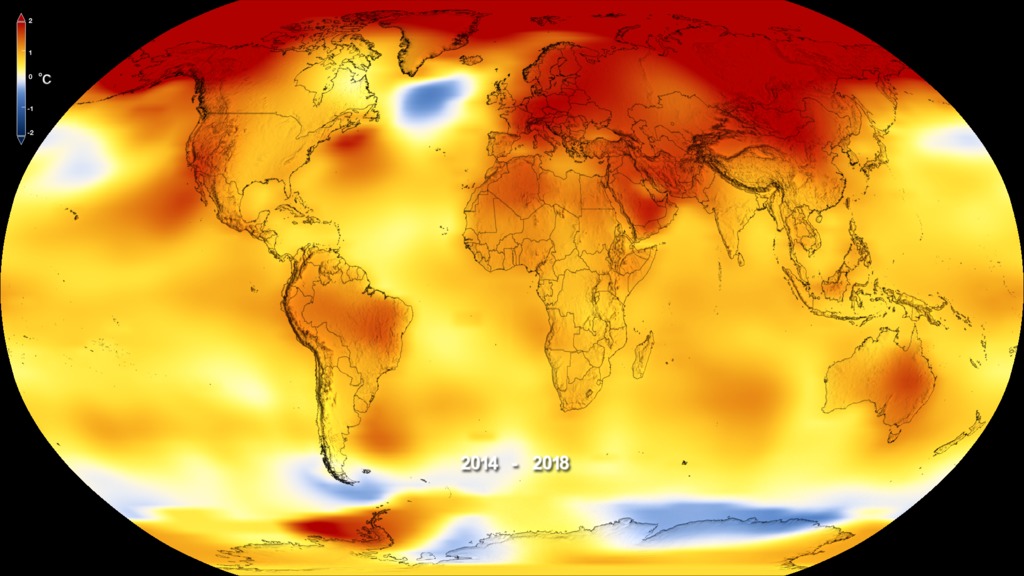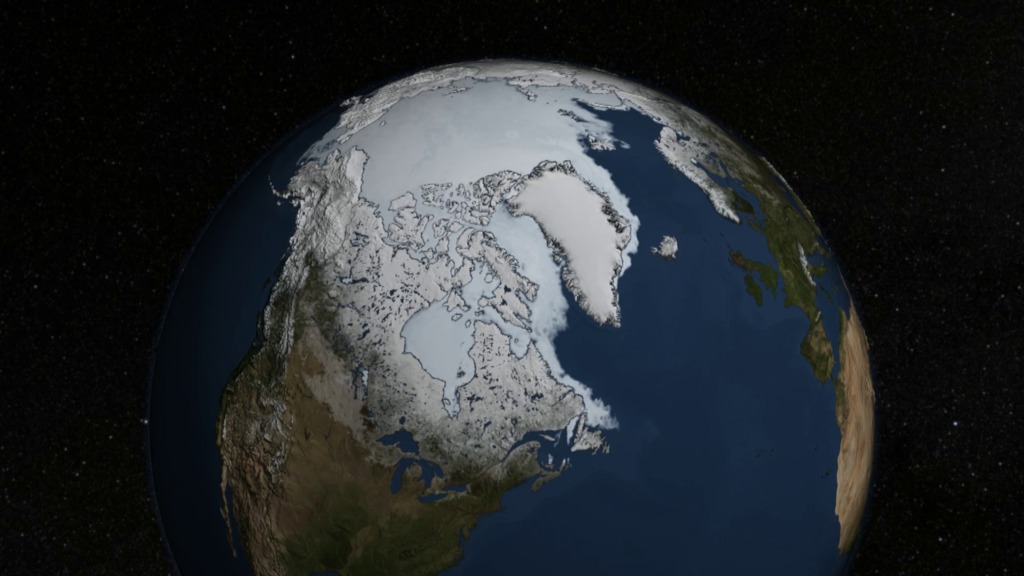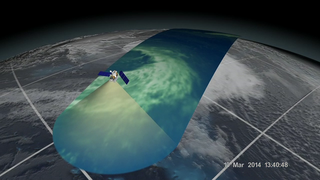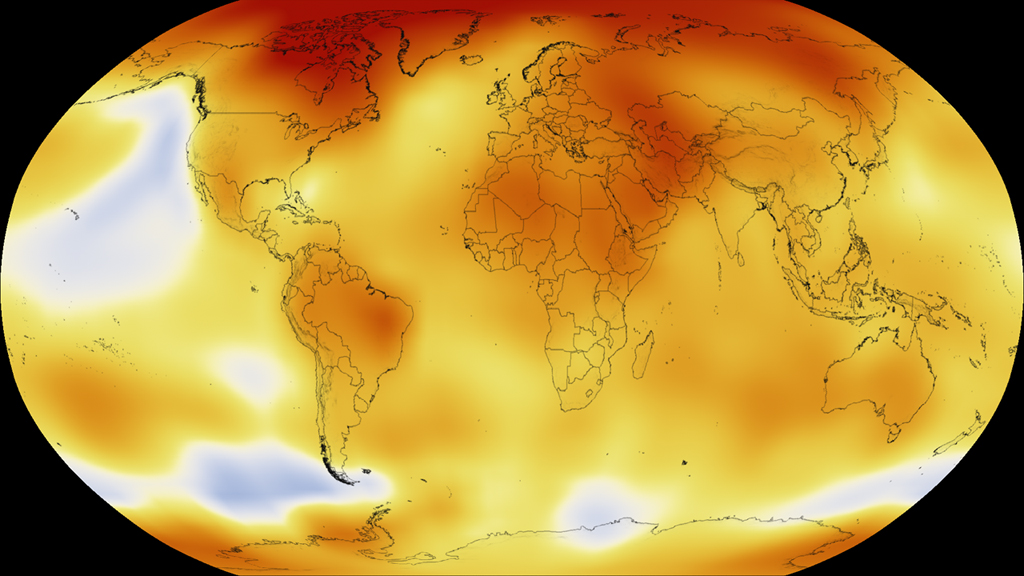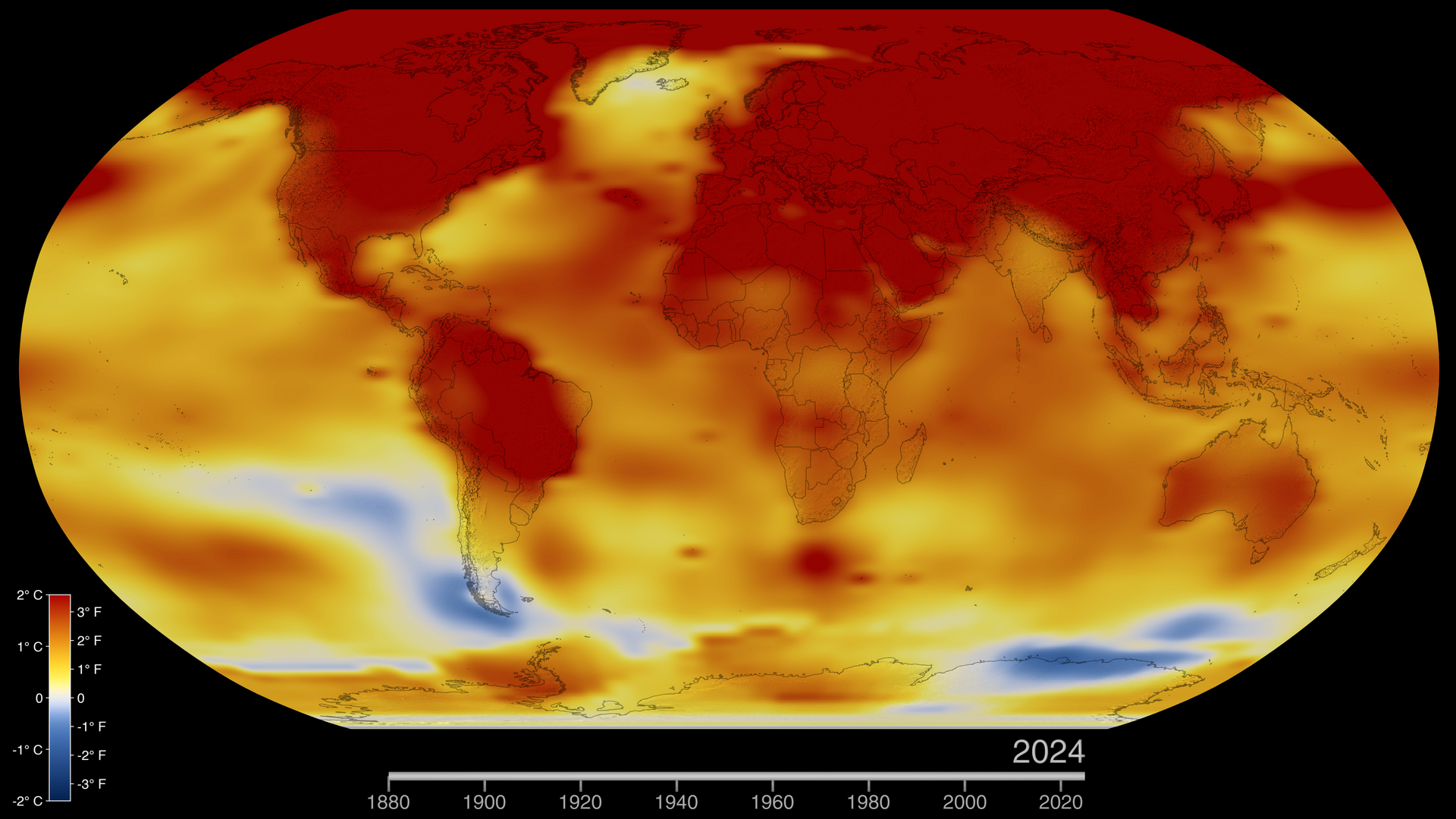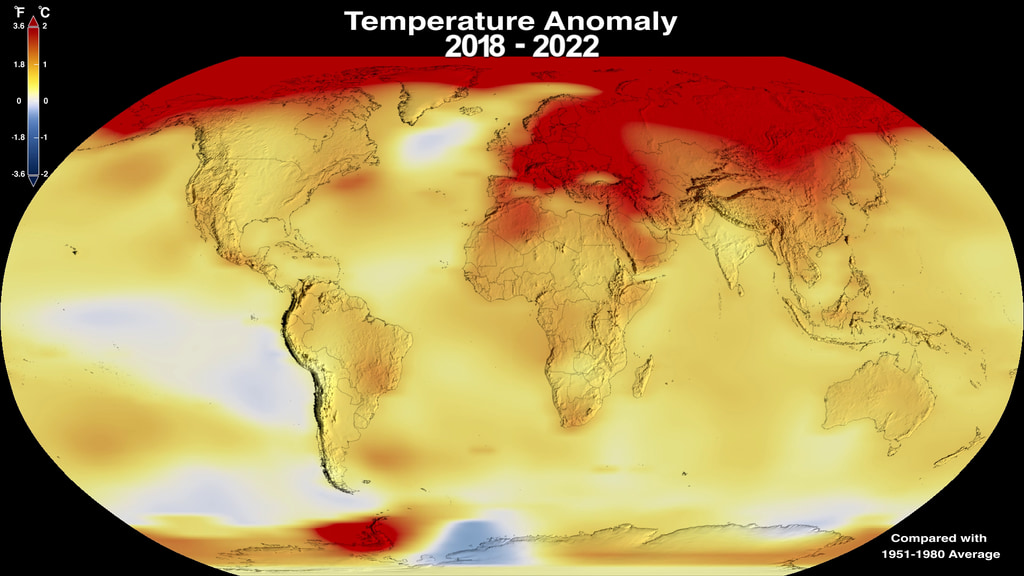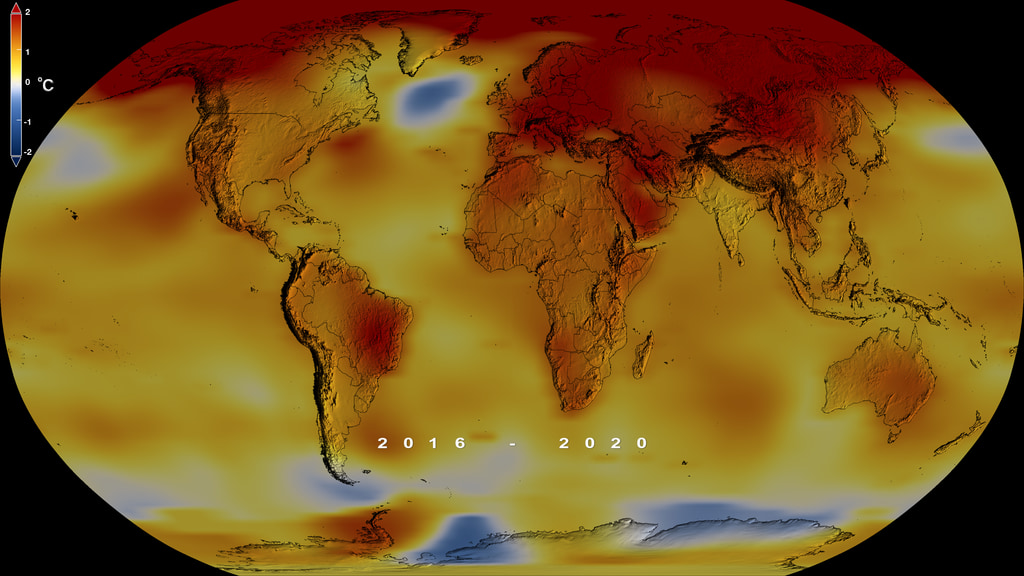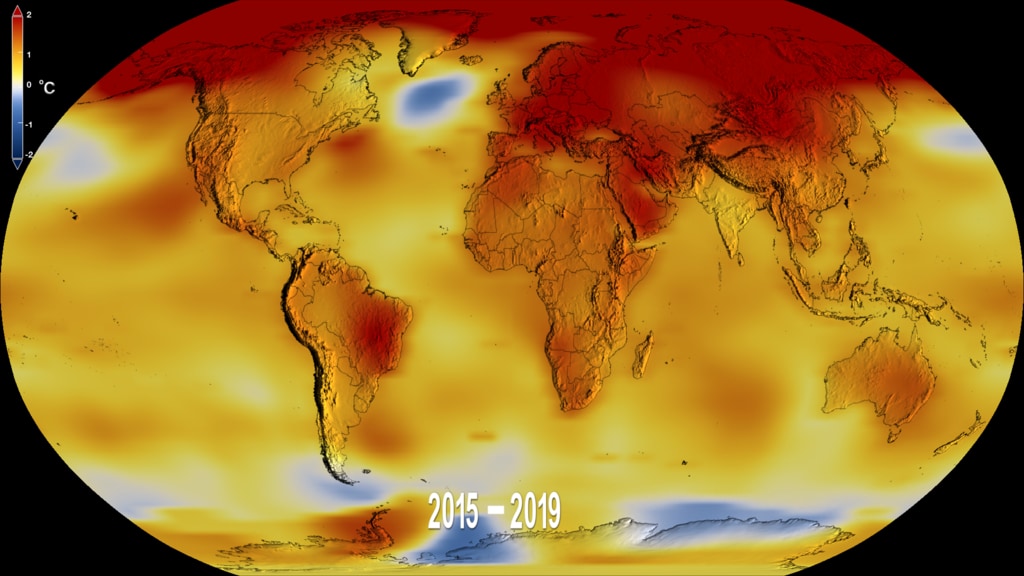A newer version of this visualization is available.
Five-Year Global Temperature Anomalies from 1880 to 2013
NASA scientists say 2013 tied with 2009 and 2006 for the seventh warmest year since 1880, continuing a long-term trend of rising global temperatures. With the exception of 1998, the 10 warmest years in the 134-year record all have occurred since 2000, with 2010 and 2005 ranking as the warmest years on record.
NASA's Goddard Institute for Space Studies (GISS) in New York, which analyzes global surface temperatures on an ongoing basis, released an updated report Tuesday on temperatures around the globe in 2013. The comparison shows how Earth continues to experience temperatures warmer than those measured several decades ago. The average temperature in 2013 was 58.3 degrees Fahrenheit (14.6 degrees Celsius), which is 1.1 °F (0.6 °C) warmer than the mid-20th century baseline. The average global temperature has risen about 1.4 °F (0.8 °C) since 1880, according to the new analysis. Exact rankings for individual years are sensitive to data inputs and analysis methods.
"Long-term trends in surface temperatures are unusual and 2013 adds to the evidence for ongoing climate change," GISS climatologist Gavin Schmidt said. "While one year or one season can be affected by random weather events, this analysis shows the necessity for continued, long-term monitoring."
Scientists emphasize that weather patterns always will cause fluctuations in average temperatures from year to year, but the continued increases in greenhouse gas levels in Earth's atmosphere are driving a long-term rise in global temperatures. Each successive year will not necessarily be warmer than the year before, but with the current level of greenhouse gas emissions, scientists expect each successive decade to be warmer than the previous.
Carbon dioxide is a greenhouse gas that traps heat and plays a major role in controlling changes to Earth's climate. It occurs naturally and also is emitted by the burning of fossil fuels for energy. Driven by increasing man-made emissions, the level of carbon dioxide in Earth's atmosphere presently is higher than at any time in the last 800,000 years. The carbon dioxide level in the atmosphere was about 285 parts per million in 1880, the first year in the GISS temperature record. By 1960, the atmospheric carbon dioxide concentration, measured at the National Oceanic and Atmospheric Administration's (NOAA) Mauna Loa Observatory in Hawaii, was about 315 parts per million. This measurement peaked last year at more than 400 parts per million.
While the world experienced relatively warm temperatures in 2013, the continental United States experienced the 42nd warmest year on record, according to GISS analysis. For some other countries, such as Australia, 2013 was the hottest year on record.
The temperature analysis produced at GISS is compiled from weather data from more than 1,000 meteorological stations around the world, satellite observations of sea-surface temperature, and Antarctic research station measurements, taking into account station history and urban heat island effects. Software is used to calculate the difference between surface temperature in a given month and the average temperature for the same place from 1951 to 1980. This three-decade period functions as a baseline for the analysis. It has been 38 years since the recording of a year of cooler than average temperatures.
The GISS temperature record is one of several global temperature analyses, along with those produced by the Met Office Hadley Centre in the United Kingdom and NOAA's National Climatic Data Center in Asheville, N.C. These three primary records use slightly different methods, but overall, their trends show close agreement.
Additional commentary on the 2013 temperature anomaly is provided by Dr. James Hansen of Columbia University at: http://www.columbia.edu/~jeh1/mailings/2014/20140121_Temperature2013.pdf
The GISTEMP analysis website is located at: http://data.giss.nasa.gov/gistemp/
This color-coded map in Robinson projection displays a progression of changing global surface temperatures anomalies from 1880 through 2013. Higher than normal temperatures are shown in red and lower then normal temperatures are shown in blue.The final frame represents global temperature anomalies averaged from 2009 through 2013.

This color-coded map displays the above progression of changing global surface temperatures anomalies from 1880 through 2013 without the date and colorbar overlays.

Global Temperature Anomalies averaged from 2009 to 2013 in Robinson projection.

Temperature Difference Colorbar
This is the frame matched date overlay that corresponds to the data.
Abbreviated 14 second movie starting from 1950 through 2013 with dates and colorbar applied.
Abbreviated 7 second movie which starts in 1950 and runs through 2013 with dates and colorbar.
This frame set is designed to be used on the Science On a Sphere display. It contains the five-year rolling averages that start with (1880 through 1884) and end with (2009 through 2013).
This 1920 by 1080 pixel frame sequence has each 5 year rolling average beginning with the first data set from 1880-1884 and ending with the last data set from 2009-2014 without any transition frames included.
For More Information
See GPM web site
Credits
Please give credit for this item to:
NASA/Goddard Space Flight Center Scientific Visualization Studio
Data provided by Robert B. Schmunk (NASA/GSFC GISS)
-
Animator
- Lori Perkins (NASA/GSFC)
-
Producer
-
Scientists
- Gavin A. Schmidt (NASA/GSFC GISS)
- Robert B Schmunk (SIGMA Space Partners, LLC.)
- Reto A. Ruedy (SIGMA Space Partners, LLC.)
- Kwok-Wai Ken Lo (SIGMA Space Partners, LLC.)
- Makiko Sato (Columbia University, Center for Climate Systems Research)
-
Project support
- Robert B Schmunk (SIGMA Space Partners, LLC.)
-
Writer
- Patrick Lynch (Wyle Information Systems)
Release date
This page was originally published on Tuesday, January 21, 2014.
This page was last updated on Sunday, February 2, 2025 at 10:13 PM EST.
Series
This page can be found in the following series:Datasets used
-
GISTEMP [GISS Surface Temperature Analysis (GISTEMP)]
ID: 585The GISS Surface Temperature Analysis version 4 (GISTEMP v4) is an estimate of global surface temperature change. Graphs and tables are updated around the middle of every month using current data files from NOAA GHCN v4 (meteorological stations) and ERSST v5 (ocean areas), combined as described in our publications Hansen et al. (2010), Lenssen et al. (2019), and Lenssen et al. (2024).
Credit: Lenssen, N., G.A. Schmidt, M. Hendrickson, P. Jacobs, M. Menne, and R. Ruedy, 2024: A GISTEMPv4 observational uncertainty ensemble. J. Geophys. Res. Atmos., 129, no. 17, e2023JD040179, doi:10.1029/2023JD040179.
This dataset can be found at: https://data.giss.nasa.gov/gistemp/
See all pages that use this dataset
Note: While we identify the data sets used on this page, we do not store any further details, nor the data sets themselves on our site.
